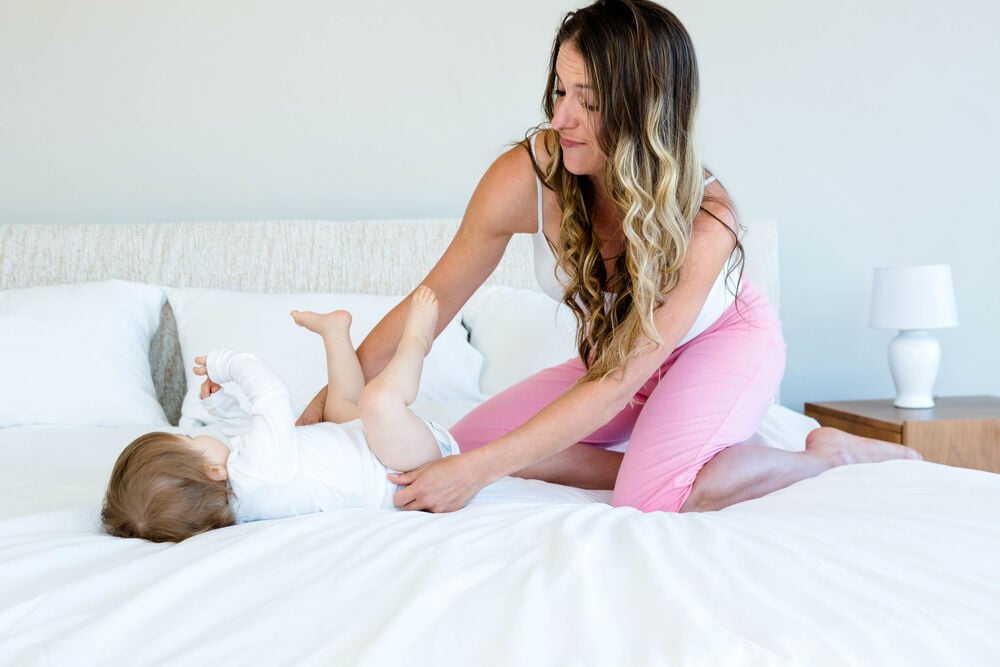If you’re a first-time parent, your baby is constantly surprising you with what they can do. Their first truly significant accomplishment, however, will be mastering the art of rolling over on their own. Wondering how you can help speed up the process? Then keep reading.
-
Tracking cycle
-
Getting pregnant
-
Pregnancy
-
Help Center
-
Flo for Partners
-
Anonymous Mode
-
Flo app reviews
-
Flo Premium New
-
Secret Chats New
-
Symptom Checker New
-
Your cycle
-
Health 360°
-
Getting pregnant
-
Pregnancy
-
Being a mom
-
LGBTQ+
-
Quizzes
-
Ovulation calculator
-
hCG calculator
-
Pregnancy test calculator
-
Menstrual cycle calculator
-
Period calculator
-
Implantation calculator
-
Pregnancy weeks to months calculator
-
Pregnancy due date calculator
-
IVF and FET due date calculator
-
Due date calculator by ultrasound
-
Medical Affairs
-
Science & Research
-
Pass It On Project New
-
Privacy Portal
-
Press Center
-
Flo Accuracy
-
Careers
-
Contact Us
When Do Babies Roll Over? A Cheat Sheet for New Parents

Every piece of content at Flo Health adheres to the highest editorial standards for language, style, and medical accuracy. To learn what we do to deliver the best health and lifestyle insights to you, check out our content review principles.
When do babies roll over?
Rolling over, unassisted, is an ability that takes a bit of practice. It’s your child’s very first attempt at complex body movement. While some may be doing it at 3 or 4 months of age, most infants will have pulled it off by the time they’re 6 or 7 months old.
They tend to start by rolling from their tummy to their back as it’s easiest. A back to tummy rollover might take a month or longer, since it requires more shoulder and neck strength.
How babies learn to roll over
This quick, seemingly isolated movement is something your child has to prepare for far in advance. At around 2 months, they’ll begin holding their head up when placed belly-side down. A few weeks later, they’ll be able to exert more weight on their forearms and keep their head and shoulders up for longer periods.
Exercises such as these build arm, shoulder, trunk, and neck muscles. You may also see your newborn flailing their arms and kicking their legs as if they’re swimming. At the 5-month mark, they’re likely lifting their chest off of the floor for an extended duration. Slowly but surely, your little one is training themselves to roll over.
I've used a lot of apps to track my period and by far Flo has been the most accurate and the easiest to use! It not only measures the days of your period, but you have the option to log ovulation, mood changes, body changes, energy level, sleep. It’s constantly updating based on what you log. Better yet, it also provides information about stress management, anatomy facts, how your diet contributes to how you feel, sleep, etc. Seriously, I’d recommend this app 110%

Take a quiz
Find out what you can do with our Health Assistant
The good news is that there are a number of ways you can assist your child in pulling off this incredible feat. Consider using the following techniques.
- More tummy time:
The routine practice of placing your infant belly-side down for long stretches is actually an effective strengthening exercise. Also known as “tummy time,” this position encourages them to learn how to hold their head and shoulders up for as long as possible. The sooner the muscles in this area develop, the sooner they’ll be rolling over!
- Changing positions:
It’s also wise to keep switching your newborn’s default resting position, be it during playtime or while breastfeeding. By alternating between laying them sideways or on their back, you’re ensuring that all their muscles are stretching and developing equally.
- Massages:
Squeeze in some extra bonding time and soothe your little one with gentle strokes to further strengthen their muscles. It may even aid in their learning of certain head, arm, and leg movements. Consult a certified pediatric massage therapist for more information on which massages work best.
- Assisted rollovers:
To help things along, try using assisted rollovers to familiarize your child with this highly-coordinated movement. The more they’re exposed to it, the likelier they’ll be to try it out on their own.
- Interaction:
Verbal and visual cues go a long way towards encouraging your infant to get moving. Talk, smile, and shower them with praise whenever they attempt to roll over. You can even place their favorite toys slightly out of reach so they’ll want to grab them.
Note that as your baby becomes increasingly active, it’s equally important for you to find ways to keep up with their energy. Try these simple tips for getting more restful sleep, so you wake up feeling as lively and refreshed as they do!
Potential issues
Every child is different and will progress in their development at their own specific pace. Be patient and try not to worry. If it takes longer than 7 or 8 months for your baby to learn how to roll over, consider consulting your pediatrician for further guidance.


Hey, I'm Anique
I started using Flo app to track my period and ovulation because we wanted to have a baby.


The Flo app helped me learn about my body and spot ovulation signs during our conception journey.


I vividly
remember the day
that we switched
Flo into
Pregnancy Mode — it was
such a special
moment.
Real stories, real results
Learn how the Flo app became an amazing cheerleader for us on our conception journey.




